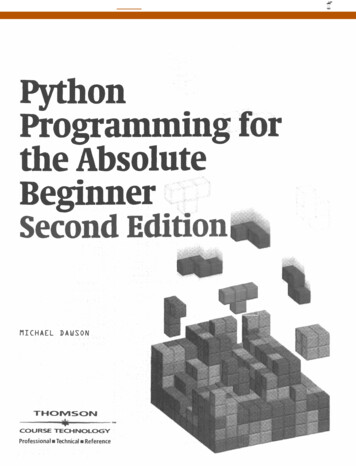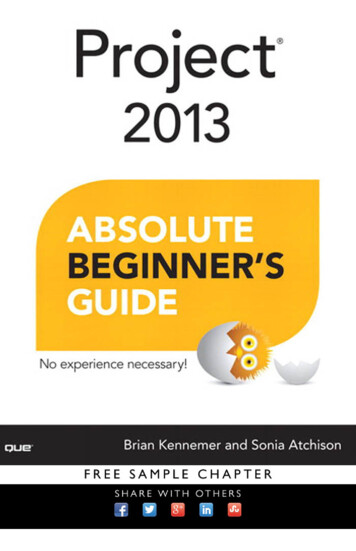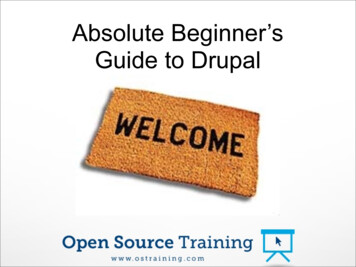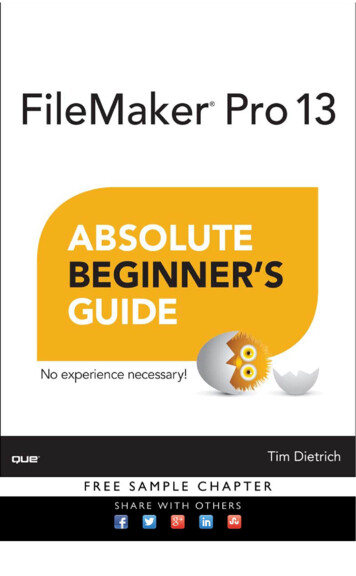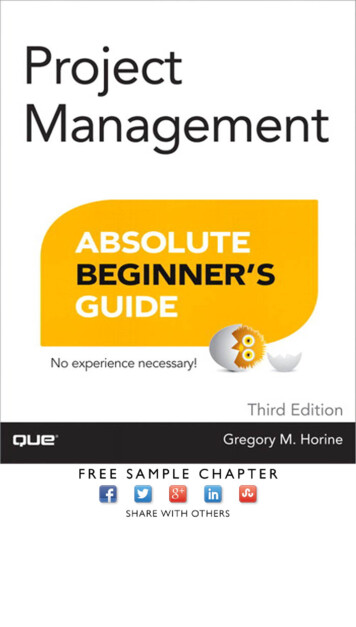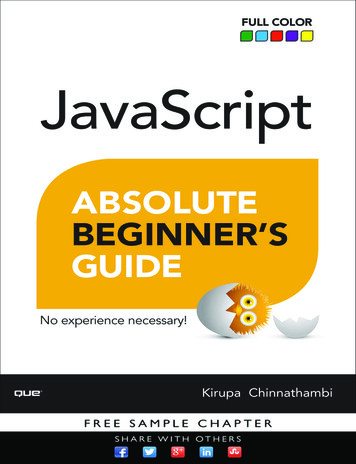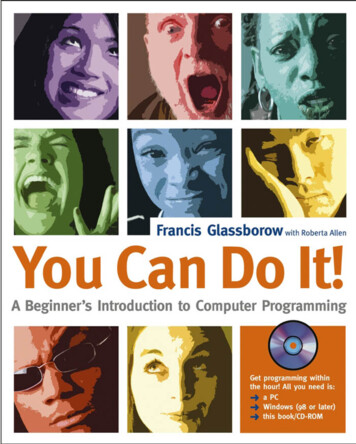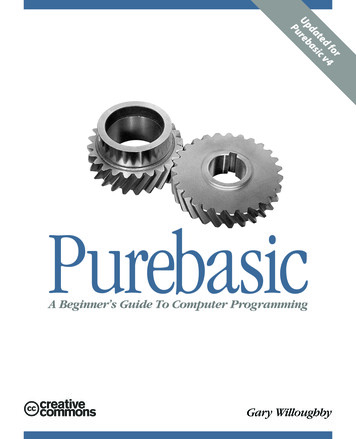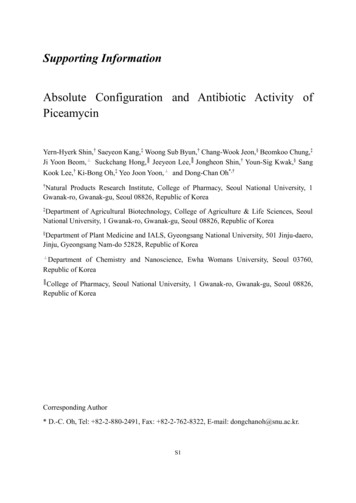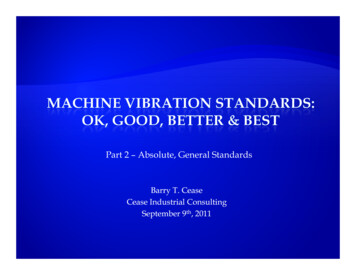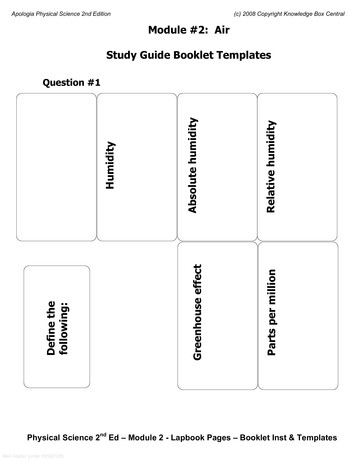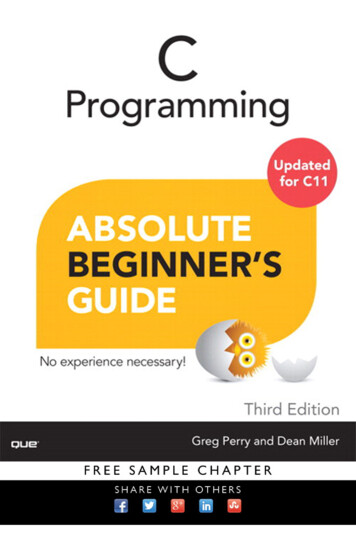
Transcription
C ProgrammingThird EditionGreg Perry and Dean Miller800 East 96th StreetIndianapolis, Indiana 46240
C Programming Absolute Beginner’s GuideThird EditionCopyright 2014 by Pearson Education, Inc.All rights reserved. No part of this book shall be reproduced, stored ina retrieval system, or transmitted by any means, electronic, mechanical,photocopying, recording, or otherwise, without written permission fromthe publisher. No patent liability is assumed with respect to the use ofthe information contained herein. Although every precaution has beentaken in the preparation of this book, the publisher and authors assume noresponsibility for errors or omissions. Nor is any liability assumed for damagesresulting from the use of the information contained herein.ISBN-13: 978-0-7897-5198-0ISBN-10: 0-7897-5198-4Library of Congress Control Number: 2013943628Printed in the United States of AmericaFirst Printing: August 2013TrademarksAll terms mentioned in this book that are known to be trademarks or servicemarks have been appropriately capitalized. Que Publishing cannot attest tothe accuracy of this information. Use of a term in this book should not beregarded as affecting the validity of any trademark or service mark.Warning and DisclaimerEvery effort has been made to make this book as complete and as accurateas possible, but no warranty or fitness is implied. The information provided ison an “as is” basis. The authors and the publisher shall have neither liabilitynor responsibility to any person or entity with respect to any loss or damagesarising from the information contained in this book or from the use of theprograms accompanying it.Bulk SalesQue Publishing offers excellent discounts on this book when ordered inquantity for bulk purchases or special sales. For more information, pleasecontactU.S. Corporate and Government or sales outside the United States, please contactInternational Salesinternational@pearsoned.comAcquisitions EditorMark TaberManaging EditorSandra SchroederProject EditorMandie FrankCopy EditorKrista Hansing EditorialServices, Inc.IndexerBrad HerrimanProofreaderAnne GoebelTechnical EditorGreg PerryPublishing CoordinatorVanessa EvansInterior DesignerAnne JonesCover DesignerMatt ColemanCompositorTnT Design, Inc.
Contents at a GlanceIntroduction. 1Part I: Jumping Right In12345678What Is C Programming, and Why Should I Care? . 5Writing Your First C Program. 13What Does This Do? Clarifying Your Code with Comments. 23Your World Premiere—Putting Your Program’s ResultsUp on the Screen . 31Adding Variables to Your Programs. 41Adding Words to Your Programs . 49Making Your Programs More Powerful with#include and #define . 57Interacting with Users . 65Part II: Putting C to Work for You with Operators and Expressions910111213Crunching the Numbers—Letting C Handle Math for You . 73Powering Up Your Variables with Assignments and Expressions . 83The Fork in the Road—Testing Data to Pick a Path. 91Juggling Several Choices with Logical Operators .103A Bigger Bag of Tricks—Some More Operators forYour Programs .115Part III: Fleshing Out Your Programs14151617181920Code Repeat—Using Loops to Save Time and Effort .123Looking for Another Way to Create Loops .131Breaking in and out of Looped Code .141Making the case for the switch Statement .149Increasing Your Program’s Output (and Input) .163Getting More from Your Strings .171Advanced Math (for the Computer, Not You!) .181Part IV: Managing Data with Your C Programs21222324252627Dealing with Arrays .193Searching Arrays.201Alphabetizing and Arranging Your Data .209Solving the Mystery of Pointers .221Arrays and Pointers .231Maximizing Your Computer’s Memory .243Setting Up Your Data with Structures .257
ivPart V: Files and Functions2829303132Saving Sequential Files to Your Computer .267Saving Random Files to Your Computer .277Organizing Your Programs with Functions .285Passing Variables to Your Functions .293Returning Data from Your Functions .305AppendixesABThe ASCII Table .313The Draw Poker Program .319Index .331
Table of ContentsIntroduction . 1Who’s This Book For?. 2What Makes This Book Different? . 2This Book’s Design Elements . 3How Can I Have Fun with C? . 4What Do I Do Now? . 4Part I: Jumping Right In1What Is C Programming, and Why Should I Care? . 5What Is a Program? . 6What You Need to Write C Programs . 7The Programming Process. 10Using C . 112Writing Your First C Program .13A Down-and-Dirty Chunk of Code . 14The main() Function . 16Kinds of Data . 17Characters and C . 18Numbers in C . 19Wrapping Things Up with Another Example Program . 213What Does This Do? Clarifying Your Code with Comments.23Commenting on Your Code . 24Specifying Comments . 25Whitespace. 27A Second Style for Your Comments . 284Your World Premiere—Putting Your Program’s ResultsUp on the Screen.31How to Use printf() . 32The Format of printf() . 32Printing Strings. 33
viEscape Sequences. 34Conversion Characters . 36Putting It All Together with a Code Example. 385Adding Variables to Your Programs .41Kinds of Variables . 42Naming Variables . 43Defining Variables. 44Storing Data in Variables . 456Adding Words to Your Programs .49Understanding the String Terminator . 50The Length of Strings. 51Character Arrays: Lists of Characters . 52Initializing Strings. 547Making Your Programs More Powerful with #include and #define .57Including Files . 58Placing #include Directives . 60Defining Constants . 60Building a Header File and Program . 628Interacting with Users .65Looking at scanf() . 66Prompting for scanf(). 66Problems with scanf() . 68Part II: Putting C to Work for You with Operators and Expressions9Crunching the Numbers—Letting C Handle Math for You .73Basic Arithmetic . 74Order of Operators . 77Break the Rules with Parentheses . 79Assignments Everywhere . 80
vii10 Powering Up Your Variables with Assignments and Expressions .83Compound Assignment . 84Watch That Order! . 88Typecasting: Hollywood Could Take Lessons from C . 8811 The Fork in the Road—Testing Data to Pick a Path .91Testing Data . 92Using if . 93Otherwise : Using else . 9612 Juggling Several Choices with Logical Operators . 103Getting Logical .104Avoiding the Negative .109The Order of Logical Operators .11113 A Bigger Bag of Tricks—Some More Operators for Your Programs. 115Goodbye if else; Hello, Conditional .116The Small-Change Operators: and -- .119Sizing Up the Situation .121Part III: Fleshing Out Your Programs14 Code Repeat—Using Loops to Save Time and Effort. 123while We Repeat .124Using while .125Using do while .12715 Looking for Another Way to Create Loops . 131for Repeat’s Sake! .132Working with for .13416 Breaking in and out of Looped Code . 141Take a break .142Let’s continue Working .145
viii17 Making the case for the switch Statement . 149Making the switch .151break and switch.153Efficiency Considerations .15418 Increasing Your Program’s Output (and Input) . 163putchar() and getchar() .164The Newline Consideration .167A Little Faster: getch() .16919 Getting More from Your Strings . 171Character-Testing Functions .172Is the Case Correct? .172Case-Changing Functions.176String Functions .17620 Advanced Math (for the Computer, Not You!) . 181Practicing Your Math .182Doing More Conversions .183Getting into Trig and Other Really Hard Stuff.184Getting Random .187Part IV: Managing Data with Your C Programs21 Dealing with Arrays . 193Reviewing Arrays .194Putting Values in Arrays .19722 Searching Arrays . 201Filling Arrays.202Finders, Keepers .20223 Alphabetizing and Arranging Your Data . 209Putting Your House in Order: Sorting .210Faster Searches .215
ix24 Solving the Mystery of Pointers. 221Memory Addresses.222Defining Pointer Variables .222Using the Dereferencing * .22525 Arrays and Pointers . 231Array Names Are Pointers .232Getting Down in the List .233Characters and Pointers .234Be Careful with Lengths .234Arrays of Pointers .23626 Maximizing Your Computer’s Memory. 243Thinking of the Heap .244But Why Do I Need the Heap? .245How Do I Allocate the Heap? .246If There’s Not Enough Heap Memory .249Freeing Heap Memory .250Multiple Allocations.25027 Setting Up Your Data with Structures . 257Defining a Structure .258Putting Data in Structure Variables .262Part V: Files and Functions28 Saving Sequential Files to Your Computer . 267Disk Files.268Opening a File .268Using Sequential Files .27029 Saving Random Files to Your Computer. 277Opening Random Files .278Moving Around in a File .279
x30 Organizing Your Programs with Functions. 285Form Follows C Functions .286Local or Global?.29031 Passing Variables to Your Functions . 293Passing Arguments .294Methods of Passing Arguments .294Passing by Value .295Passing by Address .29732 Returning Data from Your Functions. 305Returning Values .306The return Data Type.309One Last Step: Prototype .309Wrapping Things Up .312AppendixesAThe ASCII Table . 313BThe Draw Poker Program . 319Index . 331
xiAbout the AuthorsGreg Perry is a speaker and writer in both the programming and applicationssides of computing. He is known for bringing programming topics down to thebeginner’s level. Perry has been a programmer and trainer for two decades. Hereceived his first degree in computer science and then earned a Master’s degreein corporate finance. Besides writing, he consults and lectures across the country,including at the acclaimed Software Development programming conferences.Perry is the author of more than 75 other computer books. In his spare time, hegives lectures on traveling in Italy, his second favorite place to be.Dean Miller is a writer and editor with more than 20 years of experience in boththe publishing and licensed consumer product businesses. Over the years, hehas created or helped shape a number of bestselling books and series, includingTeach Yourself in 21 Days, Teach Yourself in 24 Hours, and the Unleashedseries, all from Sams Publishing. He has written books on C programming andprofessional wrestling, and is still looking for a way to combine the two into onestrange amalgam.
xiiDedicationTo my wife and best friend, Fran Hatton, who’s always supported my dreams and wasan incredible rock during the most challenging year of my professional career.AcknowledgmentsGreg: My thanks go to all my friends at Pearson. Most writers would refer to themas editors; to me, they are friends. I want all my readers to understand this: Thepeople at Pearson care about you most of all. The things they do result from theirconcern for your knowledge and enjoyment.On a more personal note, my beautiful bride, Jayne; my mother, Bettye Perry;and my friends, who wonder how I find the time to write, all deserve credit forsupporting my need to write.Dean: Thanks to Mark Taber for considering me for this project. I started myprofessional life in computer book publishing, and it is so gratifying to return aftera 10-year hiatus. I’d like to thank Greg Perry for creating outstanding first andsecond editions upon which this version of the book is based. It was an honorworking with him as his editor for the first two editions and a greater honor tocoauthor this edition. I can only hope I did it justice. I appreciate the amazingwork the editorial team of Mandie Frank, Krista Hansing, and the production teamat Pearson put into this book.On a personal level, I have to thank my three children, John, Alice, and Maggieand my wife Fran for their unending patience and support.
xiiiWe Want to Hear from You!As the reader of this book, you are our most important critic and commentator.We value your opinion and want to know what we’re doing right, what we coulddo better, what areas you’d like to see us publish in, and any other words ofwisdom you’re willing to pass our way.We welcome your comments. You can email or write to let us know what youdid or didn’t like about this book—as well as what we can do to make our booksbetter.Please note that we cannot help you with technical problems related to thetopic of this book and may not be able to reply personally to every message wereceive.When you write, please be sure to include this book’s title, edition number, andauthors, as well as your name and contact information. We will carefully reviewyour comments and share them with the authors and editors who worked on thebook.Email:feedback@quepublishing.comMail:Que Publishing800 East 96th StreetIndianapolis, IN 46240 USAReader ServicesVisit our website and register this book at http://informit.com/register forconvenient access to any updates, downloads, or errata that might be availablefor this book.
This page intentionally left blank
IN THIS INTRODUCTION Who’s This Book For? What Makes This Book Different? This Book’s Design ElementsINTRODUCTION How Can I Have Fun with C? What Do I Do Now?Are you tired of seeing your friends get C programming jobs while you’releft out in the cold? Would you like to learn C but just don’t have theenergy? Is your old, worn-out computer in need of a hot programminglanguage to spice up its circuits? This book is just what the doctor ordered!C Programming Absolute Beginner’s Guide breaks the commonality ofcomputer books by talking to you at your level without talking down toyou. This book is like your best friend sitting next to you teaching C. CProgramming Absolute Beginner’s Guide attempts to express withoutimpressing. It talks to you in plain language, not in “computerese.” Theshort chapters, line drawings, and occasionally humorous straight talkguide you through the maze of C programming faster, friendlier, and easierthan any other book available today.
2C PROGRAMMING ABSOLUTE BEGINNER’S GUIDEWho’s This Book For?This is a beginner’s book. If you have never programmed, this book is for you. Noknowledge of any programming concept is assumed. If you can’t even spell C, youcan learn to program in C with this book.The phrase absolute beginner has different meanings at different times. Maybeyou’ve tried to learn C but gave up. Many books and classes make C much moretechnical than it is. You might have programmed in other languages but are abeginner in C. If so, read on, O faithful one, because in 32 quick chapters, you’llknow C.What Makes This Book Different?This book doesn’t cloud issues with internal technical stuff that beginners in Cdon’t need. We’re of the firm belief that introductory principles have to be taughtwell and slowly. After you tackle the basics, the “harder” parts never seem hard.This book teaches you the real C that you need to get started.C can be an extremely cryptic and difficult language. Many people try to learnC more than once. The problem is simply this: Any subject, whether it be brainsurgery, mail sorting, or C programming, is easy if it’s explained properly. Nobodycan teach you anything because you have to teach yourself—but if the instructor,book, or video doing the teaching doesn’t make the subject simple and fun, youwon’t want to learn the subject.We challenge you to find a more straightforward approach to C than is offered inthe C Programming Absolute Beginner’s Guide. If you can, call one of us becausewe’d like to read it. (You thought maybe we’d offer you your money back?)Seriously, we’ve tried to provide you with a different kind of help from that whichyou find in most other places.The biggest advantage this book offers is that we really like to write C programs—and we like to teach C even more. We believe that you will learn to like C, too.
INTRODUCTION3This Book’s Design ElementsLike many computer books, this book contains lots of helpful hints, tips, warnings,and so on. You will run across many notes and sidebars that bring these specificitems to your attention.TIP Many of this book’s tricks and tips (and there are lotsof them) are highlighted as a Tip. When a really neat featureor code trick coincides wit
C Programming Greg Perry and Dean Miller 800 East 96th Street Indianapolis, Indiana 46240
